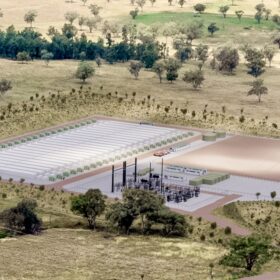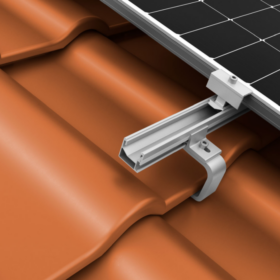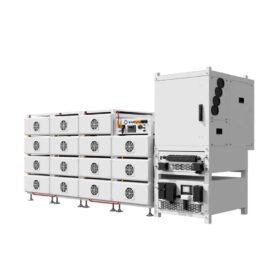Top News
Solspan unveils vertical agrivoltaics solution

Ampyr hits financial close on 600 MWh Wellington battery first stage

Tesla unveils 80 kW solar canopy at new EV charging site
Out now - pv magazine Global June edition
pv magazine Webinar

K2 Systems unveils new pitched roof mounting solutions

Deye launches C&I power conversion system with battery storage
Federal government keeps faith in SunCable project
Banpu buys into EnergyAustralia battery project
GameChange Solar introduces terrain-following tracker
Press Releases
Enphase Energy launches next-generation IQ EV Charger 2 In Australia and NZ
SA businesses to save on their power bills with new round of energy grants
AEMC appoints Geoffrey Rutledge as chief executive
WHES Tianwu C&I all-in-one ESS achieves CEC listing
Opinion & Analysis
Featured
SolarStations.org: Mapping the future of solar resource assessment
Indonesia sending mixed messages about renewables
Indonesia has the resources to quickly increase the share of renewables in its power mix, including abundant solar, geothermal and pumped storage potential to help stabilize the grid. The government has introduced policies to attract foreign investment, including through the Just Energy Transition Partnership, but it is still sending mixed signals about phasing out coal in favor of renewables.
What does Australia’s new battery rebate mean for V2G technology?
In the recent Australian election, Prime Minister Anthony Albanese’s Labor Party returned to power with a key campaign promise for a national rebate on home battery systems. This is an important and necessary step in the country’s transition to a cleaner, smarter energy future, but for those of us working on vehicle-to-grid technology (V2G) like JET Charge, there’s a question that naturally follows: what does this mean for V2G uptake?
The solar battery rebate scheme must not become ‘Pink Batts 2.0’
The Albanese Government’s $2.3 billion solar battery rebate scheme is one of the most exciting developments Australia’s energy sector has seen in years but if we don’t get the rollout right from day one, we risk undermining everything this scheme stands for and repeating the disastrous mistakes of the Pink Batts program.
The KPIs that quietly drive battery market share in Australia
The Australian residential battery market is heating up — and beneath the surface, a new set of performance metrics is emerging as decisive for brand success. While some manufacturers chase short-term growth by dropping prices, the real battle for sustainable market share is being fought on deeper metrics: share of installer adoption, share of installer portfolio, and customer loyalty.
Bringing back-contact to the foreground
Solar manufacturers are pursuing the next-generation crystalline silicon (c-Si) PV cell technology. Back-contact (xBC) technologies including TOPCon back-contact (TBC), HJT back-contact (HBC), and HJT TOPCon back-contact (HTBC) have emerged as leading candidates, attracting attention for their superior conversion efficiency and aesthetic module designs.
Markets & Policy
GPG gets state go-ahead for 400 MWh battery project
UK developer secures $718 million financing for 609 MW solar, battery portfolio
British Solar Renewables has reached financial close on a 12-project solar portfolio with three co-located battery assets. The $718 million financial package covers 536 MW of PV capacity and 146 MWh of energy storage in the United Kingdom and Australia.
Building contractor launches sustainable practice blueprint
CIMIC Group company CPB Contractors has launched a guidebook targeting its supply chain and sub-contractors to encourage unity in the construction sector to actively reduce emissions and use clean energy solutions.
$20 million greenhouse to reap solar innovation for agrivoltaic sector growth
ClearVue Technologies has joined a $20 million research project aimed at transforming agrivoltaics while generating clean energy using the company’s transparent solar glass technology.
Novel green hydrogen pilot plant wins $2.7 million grant
A Sparc Hydrogen photocatalytic water splitting reactor pilot plant under development in South Australia has been granted $2.75 million to accelerate development of the novel technology toward commercialisation.
AGL acquires South Australia virtual power plant from Tesla
Australia’s largest energy gentailer AGL has bought 100% of South Australia’s public housing virtual power plant from Tesla with intentions to integrate it with its VPP network on the east coast.
Installations
Featured
Risen hits 740 W average for mass-produced HJT module
Quinbrook brings largest UK solar plant online
Australian-owned developer Quinbrook Infrastructure Partners has announced that its 373 MW Cleve Hill Solar Park – the largest solar plant in the United Kingdom to date – is now exporting 100% of its capacity to the grid. Under construction, co-located energy storage is to come online later.
Horizon seeks federal approval for Derby solar and storage plans
Western Australian regional energy provider Horizon Power is seeking a federal green tick for a 21 MW solar-plus-battery storage project designed to help power the coastal town of Derby in the state’s Kimberly region.
Malaysian giant teams with Tasmanian landowners on 1.2 GW portfolio
Malaysian infrastructure giant Gamuda is taking the next step in its Australian growth plans, partnering with landowners in central Tasmania to co-develop a 1.2 GW portfolio of large-scale renewable energy generation and storage projects.
Robotics company lands federal funds to scale up solar construction
Robotics company Luminous has secured almost $5 million in federal government funding to support the deployment of a fleet of AI-powered robots designed to accelerate the construction of utility-scale solar farms.
Report reveals renewable energy potential of Aboriginal land holdings in NSW
A new report highlights the potential for Aboriginal land holdings in New South Wales to accelerate the state’s renewable energy transition, suggesting that strategic support could unlock more than 11 GW of solar energy or 1.6 GW of wind energy.
Technology
Featured
Perovskite solar cell efficiency improves with micro-concentrators
Clean energy research nabs over $2.6 million in grants
Over $2.6 million have been allocated to renewable energy research products involving perovskite cell commercialisation, battery cell aging, next-gen anode technology, electric vehicle charger security, and solving distributed energy resource network constraint complexity.
Tongwei achieves 91.7% bifaciality factor for 722 W TOPCon solar module
The Chinese manufacturer said the result was confirmed by TÜV Rheinland. It was achieved through a sunken pyramid structure that reportedly achieves selective-texture on the non-electrode area of rear-side and a zebra-crossing passivation contact structure that is said to ensure excellent passivation.
MoorPower takes next step on commercialisation journey
Australian wave power technology company Carnegie Clean Energy has secured new funding to advance the design of a commercial wave energy generation system for offshore applications, starting with the moored vessels used in the aquaculture sector.
How albedo interacts with rooftop PV system patterns
Researchers have simulated 160 cases of PV rooftop installation in southern and northern Italy. Among changing parameters were size and type of the panels, as well as their roof cover rate. The considered albedos were 20%, 40%, 60%, and 80%, representing different types of roof materials.
Project to test floating PV on farm dams to save water, generate electricity
The feasibility of deploying floating solar systems on farm-based water storages to optimise water retention and generate renewable energy that could serve as an alternative income stream for landholders will be investigated as part of an Australian-first research project.
Manufacturing
Featured
Brisbane battery manufacturer makes moves into US market
Trinasolar targeting ‘high-value’ markets
Yang Bao, Trinasolar’s president of global sales and marketing, recently spoke with pv magazine about the company’s strategy for the solar and energy storage business.
Australian battery maker targets military-related applications
Queensland battery technology developer Li-S Energy has signed a supply and testing agreement with an unnamed defence technology company, targeting integration of lithium-sulfur battery solutions into advanced military and security systems.
SERIS achieves world record efficiency of 26.7% for perovskite-organic tandem solar cell
The tandem device is based on a bottom organic cell that can achieve a power conversion efficiency of 17.9% and a high short-circuit current density of 28.60 mA cm2. Furthermore, it uses a top perovskite solar cell with an open-circuit voltage of 1.37 V and a fill factor of 85.5%.
Sinovoltaics tracks 86.5 GW of module output capacity for Southeast Asia
PV module manufacturing capacity in Southeast Asia has reached 86.5 GW across 61 active sites, according to Hong Kong-based quality assurance firm Sinovoltaics. The figures come from the company’s latest “Southeast Asia Solar Supply Chain Map” report.
New South Wales councils not waiting for government to mandate electrification
With just 54 months until New South Wales reaches its 2030 50% emissions reduction target, five councils are taking matters into their own hands to mandate the electrification of all new buildings, except industrial.
Energy Storage
Featured
Ausgrid accelerates vehicle-to-grid revolution in New South Wales
$9.4 billion vertically integrated battery plant breaks ground
China-headquartered battery giant Contemporary Amperex Technology (CATL), together with a subsidiary and partners have officially broken ground on a vertically integrated battery manufacturing and recycling facility in Indonesia.
Atmos reaches financial close on 400 MWh battery project
Atmos Renewables is gearing up to start building its first standalone battery energy storage project in Western Australia after reaching financial close on the 100 MW / 400 MWh system to be built near Merredin in the state’s central Wheatbelt region.
NSW green bank backs energy projects with $1 billion purse
The New South Wales government’s new green bank is now open for business with an initial $1 billion In funding available to accelerate key energy projects to support the state’s shift from coal-fired power generation to renewables.
Alinta gives construction go-ahead for 250 MW battery project in South Australia
Alinta Energy has locked in construction of the first 250 MW / 1,000 MWh stage of a 500 MW, four-hour battery energy storage system planned for South Australia and appointed local construction firm GenusPlus Group as principal contractor.
Ace Power’s 8 GWh battery project clears federal hurdle
A battery energy storage system of up to 1 GW and 8 GWh capacity has been given the green light for northern New South Wales after securing environmental approval from the federal government.


